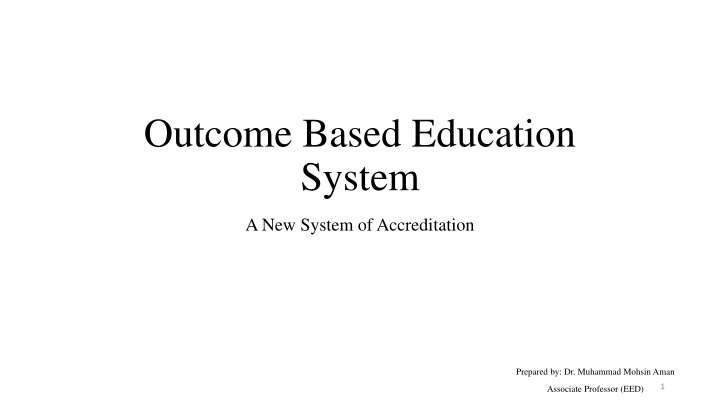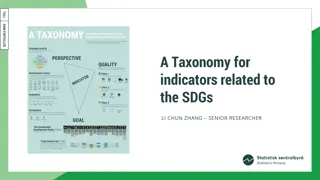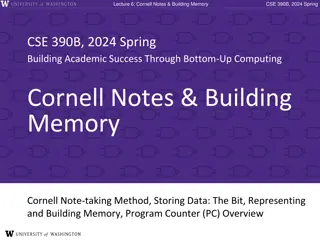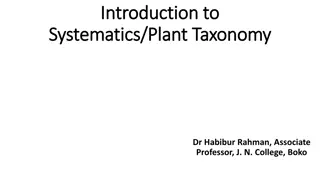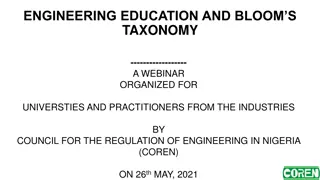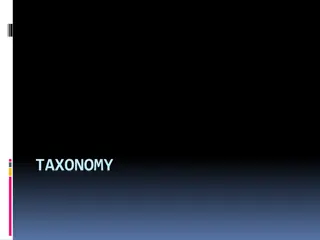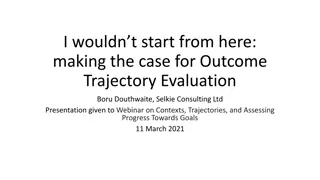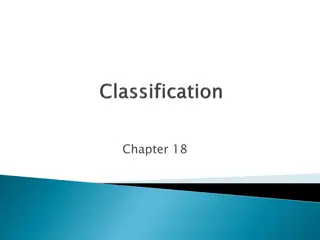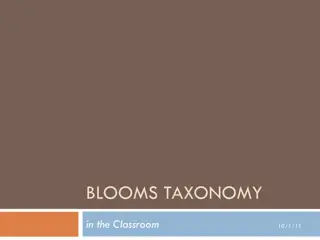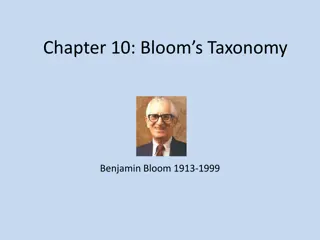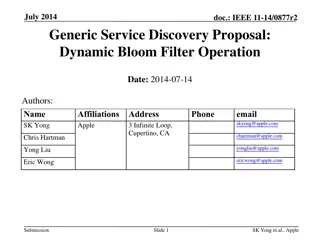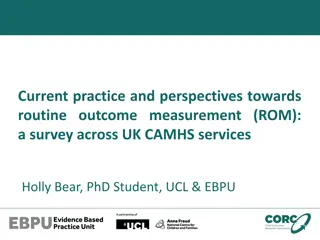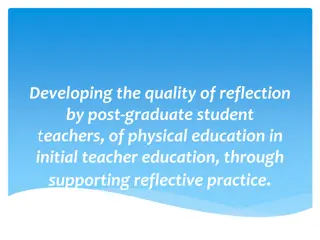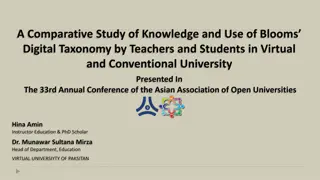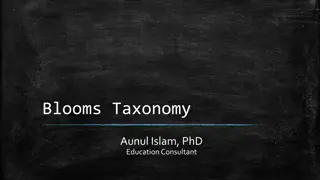Outcome-Based Education System and Bloom's Taxonomy in Engineering Education
Dr. Muhammad Mohsin Aman discusses a new system of accreditation focusing on Outcome-Based Education (OBE) in engineering education. The presentation covers Bloom's Taxonomy, OBE accreditation advantages, Washington Accord, engineering attributes, PEC and NED roles, educational objectives, learning outcomes, assessment methods, and more.
Download Presentation

Please find below an Image/Link to download the presentation.
The content on the website is provided AS IS for your information and personal use only. It may not be sold, licensed, or shared on other websites without obtaining consent from the author.If you encounter any issues during the download, it is possible that the publisher has removed the file from their server.
You are allowed to download the files provided on this website for personal or commercial use, subject to the condition that they are used lawfully. All files are the property of their respective owners.
The content on the website is provided AS IS for your information and personal use only. It may not be sold, licensed, or shared on other websites without obtaining consent from the author.
E N D
Presentation Transcript
Outcome Based Education System A New System of Accreditation Prepared by: Dr. Muhammad Mohsin Aman 1 Associate Professor (EED)
Outline of Presentation Bloom s Taxonomy OBE accreditation and Advantages Washington Accord Engineering Attributes Role of PEC NED Vision and Mission / Departmental Mission Program Education Objectives (PEOs) Program Learning Outcomes (PLOs) Course Learning Outcomes (CLOs) Complex Engineering Problem Assessment Method (Theory/ Practical) Rubrics 2
Blooms Taxonomy Taxonomy means 'a set of classification principles', or 'structure', Bloom's Taxonomy was created in 1956 under the leadership of Dr. Benjamin Bloom It refers to a classification of the different learning objectives that teachers set for students. 4
Goals of Blooms Taxonomy This taxonomy of learning behaviors may be thought of as the goals of the learning process. After a learning episode, the learner should have acquired a new skill, knowledge and attitude. Bloom's taxonomy is a set of three hierarchical models used to classify educational learning objectives into levels of complexity and specificity. The three lists cover the learning objectives in cognitive, affective and sensory domains. 5
Benjamin Samuel Bloom Benjamin Samuel Bloom (February 21, 1913 September 13, 1999) was an American educational psychologist who made contributions to the classification of educational objectives and to the theory of mastery learning. 6
Blooms Taxonomy and Engineering Programme Engineering Programme Education Training (Skill) (Knowledge and Understanding) Cognitive (Knowledge K) Psychomotor (Skill-S) Affective (Attitude-A) 7
Domains and their levels Cognitive Levels (Knowledge based) Psychomotor Levels (Skill based) Five Levels of Affective Domain (Attitude based) 9
International Engineering Alliance (IEA) & Washington Accord 13
International Engineering Alliance (IEA) The International Engineering Alliance (IEA) is a global not- for-profit organisation, which comprises members from 36 jurisdictions within 27 countries, across seven international agreements. These international agreements govern the recognition of engineering educational qualifications and professional competence. 14
International Engineering Alliance (IEA) Dublin Sydney Accord Washington Accord THE SYDNEY ACCORD IS AN INTERNATIONAL AGREEMENT BETWEEN BODIES RESPONSIBLE FOR ACCREDITING ENGINEERING TECHNOLOGY ACADEMIC PROGRAMMES. THE DUBLIN ACCORD IS AN INTERNATIONAL AGREEMENT ESTABLISHING THE REQUIRED EDUCATIONAL BASE FOR ENGINEERING TECHNICIANS. THE WASHINGTON ACCORD IS AN INTERNATIONAL AGREEMENT BETWEEN BODIES RESPONSIBLE FOR ACCREDITING ENGINEERING DEGREE PROGRAMMES. 15
Washington Accord Full Signatory Countries Signatories have full rights of participation in the accord Qualifications accredited or recognized by other signatories are recognised by each signatory as being substantially equivalent to accredited or recognised qualifications within its own jurisdiction. 17
Washington Accord Full Signatory Countries Australia Canada China Chinese Taipei Hong Kong China Ireland Japan Korea Malaysia New Zealand Russia Singapore South Africa Sri Lanka Turkey India - Represented by National Board Accreditation (2014) United States Represented Accreditation Board for Engineering Technology (1989) United Represented Engineering United (ECUK) (1989) Pakistan - Represented by Pakistan Engineering Council (PEC) (2017) Peru (2018) and (ABET) Kingdom - by Council Kingdom of (NBA) - by 18
Engineering/ Graduate Attributes (EA) 19
Employers Rating of Skills/Qualities 2002 1. 2. 3. 4. 5. 6. 7. 8. 9. 10. 11. 12. 13. 14. 15. 16. 17. 18. 19. 20. Communication (verbal & written) Honesty/Integrity Teamwork skills Interpersonal skills Strong work ethics Motivation & initiative Flexibility/adaptability Analytical skills Computer skills Organisational skills Detail oriented Leadership skills Self confidence Friendly/outgoing personality Well mannered / polite Tactfulness GPA (3.0 or better) Creativity Sense of humour Entrepreneurial skills/risk taker 4.69 4.59 4.54 4.50 4.46 4.42 4.41 4.36 4.21 4.05 4.00 3.97 3.95 3.85 3.82 3.75 3.68 3.59 3.25 3.23 20
Graduate Attributes The program must demonstrate that by the time of graduation the students have attained a certain set of knowledge, skills and behavioral traits, at-least to some acceptable minimum level. 21
Graduate Attributes Specifically, it is to be demonstrated that the students have acquired the following graduate attributes: 1. Engineering Knowledge 2. Problem Analysis 3. Design/Development of Solutions 4. Investigation 5. Modern Tool Usage 6. The Engineer and Society 7. Environment and Sustainability 8. Ethics 9. Individual and Team Work 10. Communication 11. Project Management 12. Lifelong Learning 22
Role of PEC 23
Role of PEC The main statutory functions of PEC include registration of engineers, consulting engineers, constructors/operators and accreditation of engineering programmes offered by universities/institutions, ensuring and managing of continuing professional development, assisting the Federal Government as Think Tank. The council shall encourage, facilitate and regulate working of professional engineering bodies for creativity and as custodians of engineering under the umbrella of the Council. 24
Outcome Based Education (OBE) 25
Outcome Based Education (OBE) OBE is a process that involves assessment and evaluation practices in education to reflect the attainment of expected learning and showing mastery in the programme area. 26
Advantage of OBE system HEC, PEC and many educational institutions of Pakistan are now moving towards OBE because of its relative advantages over the traditional education system. OBE emphasizes the achievement of student outcomes and thus improves the quality of education and will bring it at par with international standards. Outcome-based educational method has been adopted in education systems around the world, from primary to higher education levels. Accreditation bodies like Accreditation Board for Engineering and Technology (ABET) and Washington Accord both accept OBE as the only teaching methodology. As most Pakistani engineering programs are aiming to get the OBE accreditation from Washington Accord, it is the need of the day to develop a thorough understanding of this new paradigm in Pakistan and be on the frontlines of this change process. Ref: ww3.comsats.edu.pk/obe/ 27
OBE System NED Vision and Mission Department Mission Program Mission Program Educational Objectives (PEOs) Program Learning Outcomes (PLOs) Course Learning Outcomes (CLOs) 29
University Vision Be a leader in enabling Pakistan's social and economic transformation 30
University Mission Acquire education and research excellence in engineering and allied disciplines to produce leadership and enabling application of knowledge and skills for the benefit of the society with integrity and wisdom. 31
Department Mission To provide a quality education and contemporary research environment that is both sustainable and conducive to acquiring knowledge, relevant skills and professional attitude culminating in informed individuals ready to embrace lifelong learning process with recognition of their role in the society. 32
Department Mission The mission of the program is to equip students with technical and analytical skills and provide them a basis for learning of the engineering and scientific knowledge required for analysis, design, improvement and evaluation of integrated systems of people, material and equipment to increase the efficiency and productivity in the public and private sectors of the country along with meeting social responsibility in the face of national and global challenges 33
Program Educational Objectives (PEOs) 34
Program Educational Objectives (PEOs) Program outcomes are the narrower statements that describe what students are expected to know and be able to do by the time of graduation. These relate to the knowledge, skills and attitude that the students acquire while progressing through the program. The program must demonstrate that by the time of graduation the students have attained a certain set of knowledge, skills and behavioral traits, at-least to some acceptable minimum level. 35
Program Educational Objectives (PEOs) The Bachelor of Engineering (B.E.) program offered by Electrical Engineering Department NED University is designed to enable undergraduate students to PEO 1: Demonstrate clear understanding and a vision of the core domains of electrical engineering as well as contemporary interdisciplinary research areas. PEO 2: Identify prevalent engineering problems in work/social environments, propose and initiate their solutions by applying relevant knowledge and skill set innovatively while adhering to work ethics and social values. PEO 3: Pursue lifelong learning goals, continual professional development and sustainable growth of the society. 36
Program Learning Outcomes (PLOs) 37
Engineering Attributes PLO1 Engineering Knowledge: An ability to apply knowledge of mathematics, science, engineering fundamentals and an engineering specialization to the solution of complex engineering problems. PLO2 Problem Analysis: An ability to identify, formulate, research literature, and analyze complex engineering problems reaching substantiated conclusions using first principles of mathematics, natural sciences and engineering sciences. PLO3 Design/Development of Solutions: An ability to design solutions for complex engineering problems and design systems, components or processes that meet specified needs with appropriate consideration for public health and safety, cultural, societal, and environmental considerations. PLO4 Investigation: An ability to investigate complex engineering problems in a methodical way including literature survey, design and conduct of experiments, analysis and interpretation of experimental data, and synthesis of information to derive valid conclusions. 38
Engineering Attributes PLO5 Modern Tool Usage: An ability to create, select and apply appropriate techniques, resources, and modern engineering and IT tools, including prediction and modeling, to complex engineering activities, with an understanding of the limitations. PLO6 The Engineer and Society: An ability to apply reasoning informed by contextual knowledge to assess societal, health, safety, legal and cultural issues and the consequent responsibilities relevant to professional engineering practice and solution to complex engineering problems. PLO7 Environment and Sustainability: An ability to understand the impact of professional engineering solutions in societal and environmental contexts and demonstrate knowledge of and need for sustainable development. PLO8 Ethics: Apply ethical principles and commit to professional ethics and responsibilities and norms of engineering practice. 39
Engineering Attributes PLO9 Individual and Team Work: An ability to work effectively, as an individual or in a team, on multifaceted and /or multidisciplinary settings. PLO10 Communication: An ability to communicate effectively, orally as well as in writing, on complex engineering activities with the engineering community and with society at large, such as being able to comprehend and write effective reports and design documentation, make effective presentations, and give and receive clear instructions. PLO11 Project Management: An ability to demonstrate management skills and apply engineering principles to one s own work, as a member and/or leader in a team, to manage projects in a multidisciplinary environment. PLO12 Lifelong Learning: An ability to recognize importance of, and pursue lifelong learning in the broader context of innovation and technological developments. 40
PLO And PEO mapping PLOs PLO 1 PLO 2 PLO 3 PLO 4 PLO 5 PLO 6 PLO 7 PLO 8 PLO 9 PLO 10 PLO 11 PLO 12 PLOs Meaning Engineering Knowledge Problem Analysis Design/Development of Solutions Investigation Modern Tool Usage The Engineer and Society Environment and Sustainability Ethics Individual and Team Work Communication Project Management Lifelong Learning PEO-1 PEO-2 PEO-3 42
Depth of Knowledge Complex Problems Broadly Defined Problems Well defined Problems Can be solved using limited theoretical knowledge, but normally requires extensive practical knowledge Requires in-depth knowledge that allows a fundamentals-based first principles analytical approach Requires knowledge of principles and applied procedures or methodologies 44
Attributes Complex Problems Preamble Engineering problems which cannot be resolved without in-depth engineering knowledge and having some or all of the following characteristics: Range of conflicting requirements Involve wide-ranging or conflicting technical, engineering and other issues Depth of analysis required Have no obvious solution and require abstract thinking, originality in analysis to formulate suitable models Depth of knowledge required Requires in-depth knowledge that allows a fundamentals-based first principles analytical approach Familiarity of issues Involve infrequently encountered issues Level of problem Are outside problems encompassed by standards and codes of practice for professional engineering Extent of stakeholder involvement and level of conflicting requirements Involve diverse groups of stakeholders with widely varying needs Consequences Have significant consequences in a range of contexts Interdependence Are high level problems possibly including many component parts or sub-problems 45
Attributes Broadly-defined Problems Preamble Engineering problems having some or all of the following characteristics: Range of conflicting requirements Involve a variety of factors which may impose conflicting constraints Depth of analysis required Can be solved by application of well-proven analysis techniques Depth of knowledge required Requires knowledge of principles and applied procedures or methodologies Familiarity of issues Belong to families of familiar problems which are solved in well-accepted ways; Level of problem May be partially outside those encompassed by standards or codes of practice Extent of stakeholder involvement and level of conflicting requirements Involve several groups of stakeholders with differing and occasionally conflicting needs Consequences Have consequences which are important locally, but may extend more widely Interdependence Are parts of, or systems within complex engineering problems 46
Depth of Knowledge Complex Engineering Problems and Open Ended Problems are part of evaluation OBE system to develop and evaluate critical thinking in a student. Complex engineering problems are provided to students on individual or group basis in some subjects of the curriculum. These problems are intended to develop analytical, logical and research skills of the students. These tasks provide opportunity to student to achieve the desirable tasks with their learned skills. The scenarios of the problem do not bound the students to stick strictly to that subject rather they have to blend the acquired knowledge, on hands skills and research tools to achieve the desired task. 47
Rubrics 48
Rubrics a set of instructions or rules. Rubrics based assignment & complex problems will be given to each student. Laboratory work will be assessed through rubrics 49
Rubrics for conducting ED Lab Excellent 100% Good 75% Average 50% Poor 25% Clarity of design The drawing fully describes the intent of the designer. Drawing is clear and reflects what product is. Drawing is clear but not reflective of what the product is. Drawing is not clear and is not obvious about what the product is. Drawing is clear and reflects what the product is. Proper size and scale Drawing has an excellent appearance. 80% Space is used to display the final drawing in a professional manner. 50% Space is used properly to display drawing. Not drawn to scale. Space is used to display the final drawing in a professional manner. Drawn to scale. Not drawn correctly. Drawn to scale. The title block is only 80% completed. Dimensions All important dimensions are shown on the drawing. Dimensions are correct. 80% of dimensions are done correctly. 50% of dimensions are done correctly. Improper and/or unnecessary dimensioning. Orthographic/ Isometric/ section view All views are projected correctly. 1 view is projected incorrectly. 2 view is projected incorrectly. All views are projected, but are incorrect. Graphically accurate Drawing views provided are sufficient, correct and appropriate. 80% of Drawing views provided are sufficient, correct appropriate. 50% of drawing views provided are sufficient, correct or appropriate. The drawing views provided are not sufficient, correct or appropriate. Drawing is not drawn to the appropriate scale. Drawing is to the appropriate scale. Drawing is drawn to the appropriate scale. 50
